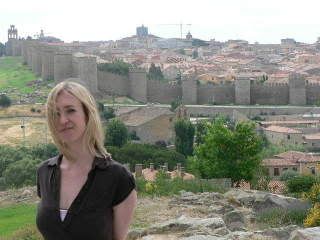
I vaguely recall how it happened, but a few weeks ago I found a program that gave me a free trip to Spain for six days. The only hitch was that I had (btw sincere sarcasm in the word 'had') to spend five days in a four-star hotel and converse with some of the most charming people on the planet who simply needed practice speaking English. What I got was a concentrated dose of Spanish culture as told by Spaniards (btw and an awesome tan). Although there was not a lot of sight-seeing, I was able to check out the walls of Avilla and the capital city of Madrid for a few days. Little did I know, when I booked accomodations for my last night in Spain, that my hotel would be right next door to the art museum holding the Guernica. The following review, to be published on my future political arts website, ensued...

Picasso’s Guernica: Tradition and Avant-garde
7.9.06
When Picasso’s now-iconic mural of the bombing of Guernica was unveiled at the Paris International Exhibition in 1937, it was met with coldness and discontent.
It was the middle of the Spanish Civil War, and the Spanish Left were wondering how this monochromatic, cubist monstrosity — at more than 11 feet high and 26 feet wide — of screaming women, children and animals, was going to advance the Spanish Republican cause. Where were the heroes in this painting, the vanguard that would bring the nationalists and the fascists down and proclaim victory?
To some, Picasso was short-sighted and indulgent in his depiction of suffering and destruction. He had missed the point of the exhibition. Alongside Guernica, a series of Spanish artists’ works were displayed proudly showing the glory of the resistance. One such piece was Alexander Calder’s Almadén, a fountain of water mixed with mercury to symbolize the prosperity of the town after a failed attack by General Franco. For it was Almadén’s mercury mines that made it a prime target for the nationalists, and the mercury-enriched water cheerily flowed like the waving of a victory flag.
Even at the height of Picasso’s career, the Guernica was not well-received. What those who initially dismissed his work did not realize was that Picasso would soon strike a chord in the hearts of millions the world over. With Guernica, Picasso portrayed one of the most endearing depictions of human suffering in war times. It is perhaps for this reason that Nelson Rockefeller donated a large reproduction of the work to hang in the Security Council Room of the United Nations. And perhaps it is for this reason that Colin Powell had a large blue curtain installed to shield the mural in 2003 for a televised press conference.
Beyond the Spanish Civil War, the Guernica was a telltale sign of things to come for Europe during WWII. Before that fateful bombing on April 26, 1937, the world had not seen such blatant use of civilians as military targets. In a town of seven thousand, 1,654 people were killed and 71 percent of the buildings were destroyed; all by German forces under Franco’s command. The ancient Basque city became a cause celebre around the world; and Picasso’s latest work was one with the zeitgeist.
Prior to Guernica, Picasso was a man with very little to zero interest in creating political art. In September of 1936, he had been commissioned by the Spanish government to contribute to the Paris exhibition. He sat on the assignment for eight months, and in that time had only come up with comic strips mocking General Franco entitled, Dream and Lie of Franco.
But on April 26, 1937, inspiration hit like a bolt of lightening; it struck via a Paris newspaper, as Picasso had been living there for the last few years. Five days later, the first sketchings of Guernica began, and would not end, even after the mural was complete. In total, there are more than sixty drawings pre and post-Guernica, all of which were not discovered until 1984.
Upon viewing the Guernica-related sketches, it is almost possible to see the line of thought behind the master; for what began as a very basic set of drawings (the scribblings of a child come to mind) slowly transforms into a very lucid vision of terror. The sketchings become a true meditation of fury, pain and heartache as seen through the eyes of women, children and animals.
In a close-up of a woman holding a child, for example, Picasso has pointedly given the character bulging, almost fish-like eyes searching the heavens, and a cavernous mouth with a piercing tongue lashing out. It is basic characteristics such as these that communicate so effectively with the viewer to reveal deep, horrific emotions. The humanity felt through Picasso’s sketches is ever-present; and its impact magnified to larger-than-life proportions through Guernica.
The great mural and its related drawings have held a home in Madrid since their relocation from the New York MOMA in 1981. Until the 3rd of September 2006, the museum will be celebrating this 25th anniversary with an exhibit called “Picasso: Tradition and the Avant-garde”. Among a treasure trove of Picasso works lye two very noteworthy pieces in the long history of visionary Spanish political art. Édouard Manet’s 1869 oil painting of the execution of the Emperor Maximilien and Goya’s The Execution of the Defenders of Madrid (1814) are portrayed as precursors to the political work of Picasso, especially when viewed alongside his 1951 piece, Massacre in Korea.
But as the Guernica firmly rests in Madrid, its spirit and message continue to float around the globe and through the ages assuring that the human cost of war will not be forgotten.




No comments:
Post a Comment